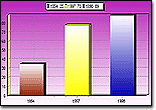Lesson Plan - Waterproof or Not?




Component
The student understands that all matter has observable, measurable
properties
The student uses productivity tools to collaborate in constructing
technology-enhanced models (charts and graphs)
Objectives
- Discuss the term "waterproof" and why it is important for some objects
to be waterproofed
- Create a list of objects that the students think
are waterproof
- Have students bring in these items
- Conduct activity
"Waterproof or Not"
- Divide class into small groups
- Give groups copy
of Waterproof or Not science sheet.
- Ask groups to:
- predict which
items will be waterproof
- determine a procedure of testing items
- test
each item and record results
- explain why item is waterproof or not (what
are its properties?)
- After collecting data about what objects are waterproof
or not, have students create a spreadsheet then graph to represent their
findings. Use the spreadsheet/chart and table application from any word
processing program. Learn how to make a graph at these sites Charts
and Graphs and Graphs
- Vocabulary: graph, line graph, pie graph, bar graph, scatter graph



Competency
Using the scientific method process skills in hands-on group investigation,
the student will determine which objects are waterproof and which are not
waterproof and will create and publish a graph representing data collected..
Extension Activities
- Using an almanac, have students discover the places (either nationwide
or worldwide) that are the wettest, hottest, coldest, snowiest, driest
and windiest. Then, locate these places on a globe, large map or desk map.
Students can then write mini weather reports about their favorite "extreme"
weather location. Fact
Book
- Brainstorm weather conditions at places in the world or in the USA
that are the wettest, hottest, coldest and so on. Using the five senses,
ask students to describe what a day would be like at one of these places. Fact
Monster
- Read about weather events at the Franklin's Forecast Weather
Index
Homework
After investigating five day weather forecasts in newspaper or online,
construct a graph depicting temperature, wind velocity, humidity and rain fall
for those days.
Field Trip
Go on a virtual field trip on the NASA web site NASA
Earth Observatory to learn about earth's atmosphere, to see pictures of the earth from space ,
and to learn about forecasting fury.
Resource
Great Investigations One Step at a Time. The National Learning Center.
1987.











